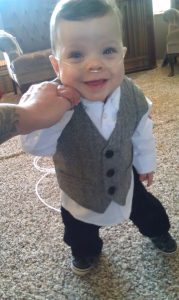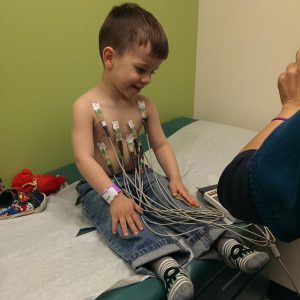
Life did not start out easily for Emmett Seymer. He and his twin brother, Dashiell, were born at 29 weeks in Allentown, Pennsylvania. Emmett spent the first 30 days of his life on a ventilator because his lungs were underdeveloped. Doctors at the hospital had little optimism for Emmett and told his mother to prepare herself for him to pass away.
After 180 days in the neonatal intensive care unit (NICU), Emmett was able to join his brother at home. Though he had significant difficulty breathing and an inability to swallow normally, he was finally stable enough to get out of the hospital.
Caring for a child with an undiagnosed condition
For the first several years of his life, Emmett was in and out of the hospital on a regular basis.
“Every time he ate, his body was trying to kill him,” Hope Seymer said of her infant son Emmett.
This may sound like an exaggeration, but in Emmett’s case, it was the literal truth. When he tried to eat or drink, he would aspirate food into his lungs, which caused him to develop respiratory distress and recurrent pneumonia. He was diagnosed with asthma, but the asthma treatments never provided complete relief.
Seymer found herself in and out of the hospital along with Emmett on a regular basis.
“I used to get a call from daycare every few weeks and then we were rushing Emmett to the hospital. That was normal. We always had two suitcases packed,” Seymer said.
Because of his condition, Emmett was often quarantined, unable to leave his room or play with his brother. The iPad given to him by his nurses was how he dealt with long, uncomfortable days.
Seymer didn’t want Emmett to live his life with a feeding tube. In a search for answers, she made contact with Dr. Jennifer Soares, medical director of the aerodigestive center at Seattle Children’s Hospital.
Making a move to find an answer
Due to frequent emergency room visits, clinic visits and hospitalizations, Seymer, a single mom, lost two jobs taking care of her son.
“I had to be there for him. It needed to be me because I’m mom and I’m all he has,” she said.

Seymer eventually moved her two young sons from Richland, Washington, to Seattle looking for answers about what would help her child and improve their life. Though they didn’t know it yet, Emmett was suffering from dysphagia, a condition where one has difficulty swallowing liquids normally and aspirates fluids and food down into the lungs.
Everything Emmett drank had to be thickened to the consistency of honey, and even then, he struggled to swallow normally and continued to aspirate resulting in ongoing illnesses and hospitalizations.
“The Seattle Children’s doctors did a two week barrage of tests to find out what was wrong,” Seymer said.
The myriad of tests included scopes of the lungs where Dr. Kaalan Johnson, the surgical director of the aerodigestive center, found the main culprit for Emmett’s struggles. Emmett had a deep interarytenoid space, an area at the back of his voice box where the aspiration was likely occurring.
Seymer finds a diagnosis
“I can remember the exact moment Drs. Johnson and Soares diagnosed what was going on,” Seymer said.
“I too remember that day in clinic,” said Soares. “It was a very difficult decision for us all to all to make as a team. Given how sick Emmett was, we were looking at either restricting all liquids by mouth and placing a G-Tube for hydration or trying a surgery called an interarytenoid suture augmentation.”
Soares, Johnson and their team went to work two weeks later to surgically change the back of Emmett’s larynx. After the procedure, 2-year-old Emmett underwent a swallow study.
“The tech and I were jumping up and down because he didn’t aspirate,” Seymer said. “I still get a little emotional about how well he’s doing and how far he’s come. I wish I could have taken a video of the first time he drank water. He was like, ‘mom, this is great!’”
“Kaalan and I were over the moon! This child could drink normally,” said Soares. “This mother could feed her child normally. Though this isn’t always the outcome with this procedure, it was successful and resulted in creating some normalcy for this wonderful family. That’s why this is so gratifying.”
Finally breathing easy
After the procedure, life immediately became very different for Emmett and his family. As he recovered at Seattle Children’s, he became enamored with the quilts he was given upon admission which are now permanently on his bed at home. He became active and whimsical. Seymer recalls watching his personality develop as he recovered.
“I’ve got the brightest, smartest little kid on the earth. He’s hysterical,” Seymer said. “Emmett’s too young to remember a lot which is good because it was rough, but he has scars that tell a lot of stories.”
Now 5 years-old and no longer worried about his next breath, Emmett is able to focus on things he enjoys like doing artwork. He draws comic books, plays with his energetic brother, Dash, and lives the life of a normal child. He loves Teenage Mutant Ninja Turtles and wants to start his own kid’s yoga class.
When asked about their journey, Seymer said the advice she would give to other parents is to be an advocate for your child, accept help and don’t try to do it all on your own. That, and to take advantage of the 24-hour Starbucks located inside the hospital.

“The hardest part for me was being the advocate I needed to be for my child” Seymer said. “But we persevered and are grateful we found the answer and treatment that has allowed Emmett to blossom into the amazing boy he is today.”

